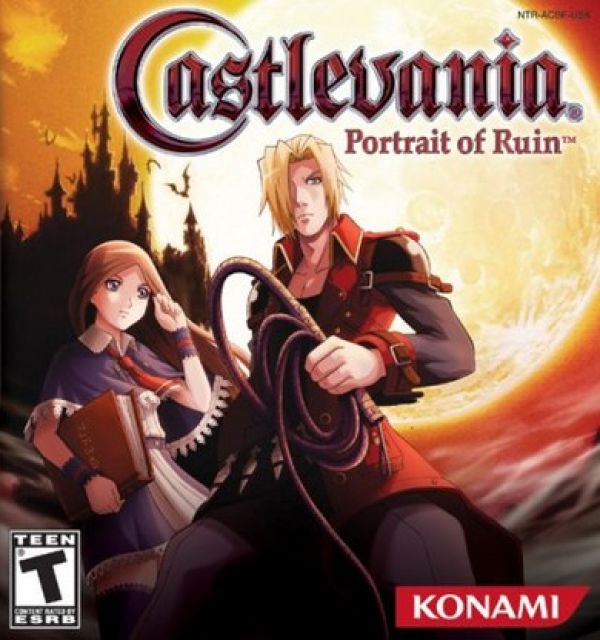Solid Castlevania entry - Not the best, but far from the worst
The Castlevania series is pretty much split into two eras - the series’ original incarnation was linear, slow-paced, and notoriously difficult. Most of these games were on the NES or SNES, but some appeared on other systems. The second era made the second half of the term “Metroidvania” – everything takes place in one seamless open level with items and upgrades to gather, the games moved faster, the later games tend to be easier (tend to be – Order of Ecclesia is monstrously difficult), and you level up and equip items to increase stats.
If you’re reading this, you probably already knew all of the previous paragraph. Castlevania: Portrait of Ruin, the second outing on the Nintendo DS and the sixth overall in the “second era” of 2D Castlevania games (SotN, CotM, HoD, AoS, DoS, and PoR), starts to straddle the line between the eras. Portrait of Ruin does still lean into the Metroidvania structure, but the castle is a fair bit smaller than Aria of Sorrow or Dawn of Sorrow. Instead, there are several portraits littered throughout the castle that can transport you to a different place entirely, much like Super Mario 64’s gigantic paintings. The levels in each of these portraits provide for some unusual settings for the Castlevania franchise – I don’t think you could fit any of them into a castle, for one – but all of the levels inside of these portraits are linear and leave only a little room for exploration. Considering that the castle also isn’t anywhere near as layered and intricate as the Sorrow games or Symphony of the Night, there’s a dearth of exploration and nooks and crannies in Portrait of Ruin.
For my part, I don’t count this as a complaint. It doesn’t mean the game has less content, though if it did I honestly wouldn’t count that as a complaint either. The castle and the levels are still well-designed and fun to get through and they’ve got a much better difficulty balance than most previous Castlevania games – it’s rarely easy but also rarely infuriatingly difficult. I will complain about the fact that the last four portraits you have to go through are all retreads of previous levels, with some minor changes in structure, environment, and some major changes in the enemies you fight – this feels like a bit of unnecessary padding and an excuse to get some classic Castlevania bosses in there. I’m not going to knock off a star for this as I still had fun going through those levels, but it was disappointing to see that the last quarter of the game mostly consists of reused parts from the first three quarters.
The game’s other primary gimmick revolves around you switching between the two primary characters, Jonathan and Charlotte (who amusingly call each other’s names whenever you switch, meaning you can mash X and endlessly hear “JONATHAN! CHARLOTTE! JONATHAN! CHARLOTTE!”). Many of the abilities you gather throughout the game involves using both of these characters in some way, from commanding someone to stay to double jumping off of their shoulders to dual-casting some spells for tons of damage. Players could finish the entire game focusing almost solely on one character or the other, although it would probably be more difficult to keep Charlotte out all the time than it would be to use Jonathan most of the time. There is at least one boss where you’re going to need to switch to Charlotte if only to avoid a Charm attack, but you could probably beat that boss solely as Jonathan if you’re pretty skilled. In any case, the game is more interesting if you switch between characters and change things up often, but I personally don’t think this is done that much better here than it was in Julius Mode in Dawn of Sorrow.
As with most other Castlevania games, the story takes a backseat to the gameplay. That’s a good thing, too, as Charlotte and Jonathan can be boiled down to a pair of annoying anime teenager stereotypes. Jonathan is a hot-headed whiny brat and Charlotte is a magical genius who points out Jonathan’s shortcomings every time she gets a chance. The actual plot here is pretty good for the type of game this is, but the two leads just aren’t all that likeable. Fortunately, they’re also far from the worst examples of their respective stereotypes, Jonathan’s character arc has him get over his problems, and most of this happens in a handful of cutscenes that last a minute or two and then you’re back to playing the game.
Castlevania: Portrait of Ruin is a solid entry in the franchise – not on top, but far from the bottom. Its biggest problem is that it’s “just” another entry – its castle design isn’t as refined as Dawn of Sorrow, nor is it as cohesive as that game; it’s not as huge or entertainingly hammy as Symphony of the Night; and it’s not as ridiculously difficult as Order of Ecclesia can be. But if you’re looking for a solid 2D action game with some exploration, you can’t go wrong with Portrait of Ruin.
